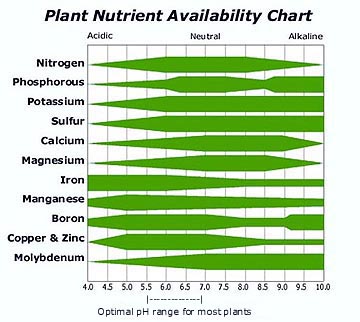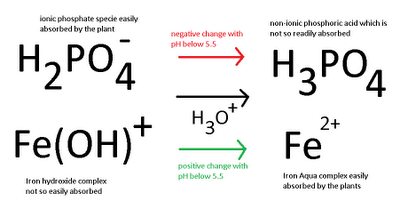–

 –
–However most growers tend to believe that the pH level of their nutrient solution is the pH level that plants have around their roots, something which is actually not correct in the sense that plants have evolved local pH adaptation mechanisms to survive to changes in soil pH. When you measure the pH of your nutrient solution you are measuring the pH of the “bulk” while the pH of the actual root-zone of your plants might be within the ideal zone for nutrient absoprtion. Therefore growers usually underestimate the actual capacity of their plants to correct pH and spend an enormous amount of time tinkering with pH to make it “ideal”.
The fact here is that plants do not like abrupt pH changes like those that happen when you add pH up/down to continuously adjust your nutrient solution’s pH levels. Plants can deal perfectly with a slow pH increase caused by nutrient absorption from 5.5 to 6.5 but when you – in a matter of seconds – revert the pH back from 6.5 to 5.5 in a matter of seconds you are causing your plants significant levels of stress since they are simply not used within their natural environment to such quick pH changes.
The easiest way I have found to deal with pH is to simply not obsess with it. Most solutions that are well balanced and contain about 10-15% of the nitrogen as ammonium and about 20-40 ppm of phosphorous will adequately contain pH within the 5.5 to 7 pH region from the beginning of your nutrient cycle to the time when the nutrient solution has to be changed. As a matter of fact – beyond the initial adjustment – the changing of pH can be avoided if the nutrient solution is adequately formulated and given in a quantity of at least one gallon per plant. Plants develop well around these pH levels and the improvement you gain from obsessing about perfect pH zone levels will be lost by the stress you put into your plant roots with pH corrections. Of course, there are easy and almost perfect solutions to pH control like the method using ion exchange resins I mentioned in a previous post. A method that mimics the way in which pH is naturally buffered within soil.
Therefore if you want to have a great hydroponic crop with little maintenance and a very good yield I would advice you to prepare your own nutrients taking pH-self balancing and adequate nutrient ratios into account. Certainly this method will give you a lot of control over your composition and a great saving in solution costs.
I hope that after reading these two posts on pH in hydroponics you have now grown a much better understanding of how pH is, how it works and how it evolves in a hydroponic culture. It is very important for you to understand that pH plays a vital role in nutrient absorption but that obsessing with strict pH zones is not beneficial for your plants in the sense that constant additions that cause quick changes in pH values cause stress to their root zone. Adequate nutrient design and a good understanding of how nutrient interact is therefore important for the correct use and low maintenance of a hydroponic crop.




